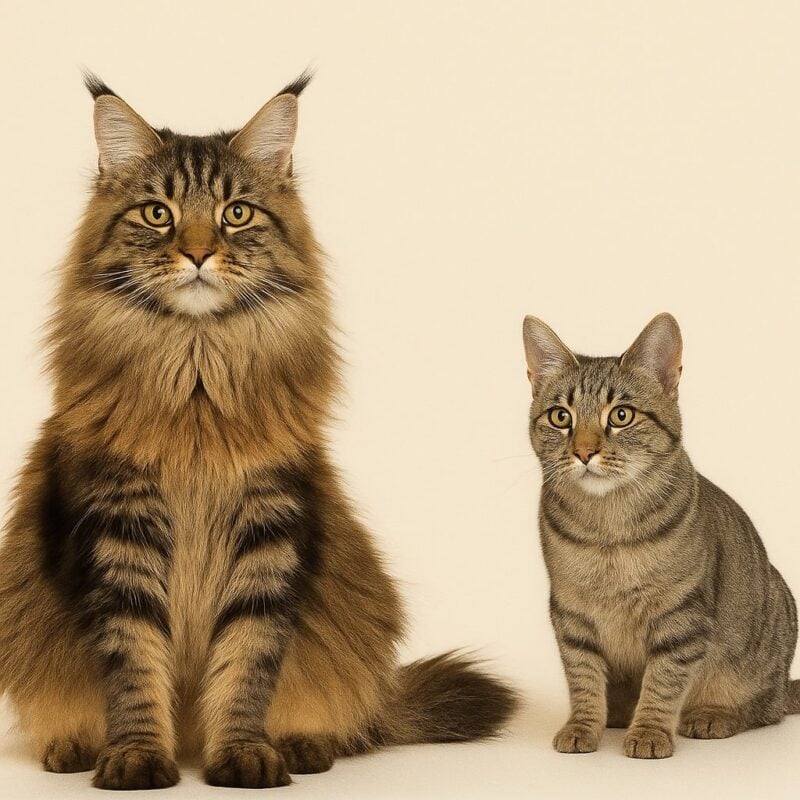13 Bizarre Reasons Why Maine Coon Laying On Their Backs!

If you’ve ever watched a Maine Coon cat lounge around, you’ve likely seen it sprawled out, belly-up, in a position that can only be described as both hilarious and endearing.
The image of a large, fluffy Maine Coon lying on its back, paws splayed out, is one of the breed’s signature quirks. While many cats, regardless of breed, might occasionally roll onto their backs, Maine Coons seem to have a particular affinity for this position!
Let’s explore the fascinating reasons behind this seemingly peculiar behavior.
Why Maine Coons Lay On Their Backs
Maine Coon cats are known for their playful and affectionate personalities, and one of their most distinctive behaviors is the tendency to lay on their backs.
This behavior is often interpreted in a variety of ways, each reflecting the Maine Coon’s unique nature.
Here’s a detailed breakdown of the reasons why your Maine Coon may lie on its back:
1. Happiness
Lying on their back is often a sign that a Maine Coon is feeling relaxed and happy. This position shows they are content and comfortable in their environment, enjoying their surroundings.
2. Trust In Owners
Cats expose their bellies as a sign of trust. Since the belly is a vulnerable area, when a Maine Coon lies on its back, it indicates a deep level of comfort and trust in their human companions.
3. Playtime
Maine Coons are playful cats, and when they roll onto their back, it could be an invitation to play. They often bat at toys or their owners’ hands in this position, which is a fun and active way to engage in play.
4. Comfort
Lying on their back may simply be the most comfortable position for a Maine Coon. With their large, muscular frames, they may prefer the freedom of spreading out their limbs in a relaxed, comfortable way.
5. Submission
In certain social dynamics, especially if there are multiple cats in the household, lying on the back may signal submission. The cat is indicating that it does not pose a threat and is willing to be passive in the interaction.
6. Defensive Position
Some Maine Coons will lie on their backs in a defensive stance. This allows them to protect their vital organs and quickly spring into action if needed.
The posture allows for both offense and defense due to their agility and physical capabilities.
7. Scratching Their Back
Cats are known to enjoy scratching their backs, and lying on their back could be a way for a Maine Coon to access the best spots for scratching. It helps them stretch and groom in a way that feels satisfying.
8. Territorial Behavior
Sometimes, lying on their back may also be a way for a Maine Coon to claim its territory.
By rolling over in a prominent position, the cat might be marking its space, ensuring that other animals or people understand its boundaries.
9. Mating Behavior
In some cases, Maine Coons may adopt this posture during mating behavior. The position can be a part of the mating ritual, signaling availability or interest in another cat.
10. Staying Close To Human Companions
Maine Coons are affectionate cats, and by lying on their back, they may be trying to stay close to their human family members. This position can be a way for them to engage with their owners or be close to them.
11. Temperature Regulation
The Maine Coon’s thick double coat can sometimes be too warm, especially during warmer weather. By lying on their back, they can expose their belly, which is typically less covered by fur, helping them cool down and regulate their body temperature.
12. Freedom And Flexibility
Maine Coons are incredibly flexible and agile cats. Their physical prowess allows them to lie in various positions that other breeds may not be able to. Lying on their back is a position that gives them the freedom to stretch, move, and be entirely comfortable.
13. Keeping An Eye On Their Surroundings
Maine Coons are known for their alert and curious nature.
By lying on their back, they may be positioning themselves in a way that allows them to observe their surroundings while still resting. This posture enables them to stay aware of what’s going on around them, which is useful for a naturally vigilant breed.






